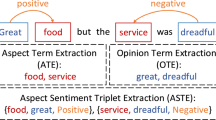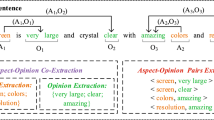Abstract
Aspect-Opinion Pair Extraction (AOPE) task aims to capture each aspect with its corresponding opinions in user reviews. Entity recognition and relation detection are two fundamental subtasks of AOPE. Although recent works take interaction into account, the two subtasks are still relatively independent during calculation. Furthermore, since AOPE task has not been formally proposed for a long time, syntactic information does not attract much attention in the current deep learning models for AOPE. In this paper, we propose a model for Synchronously Tracking Entities and Relations (STER) to deal with AOPE. Specifically, we design a network consisting of a bank of gated RNNs, where we can track all entities of a review sentence in parallel. STER utilizes three features, i.e., context, syntax and relation, to learn the representation of each tracked entity and calculate the correlated degree between all entities synchronously at each time step. The entity representation and the correlated degree are highly dependent during calculation. Finally, they will be used for entity recognition and relation detection, respectively. Therefore, in STER, the two subtasks of AOPE can achieve sufficient interaction, which enhances their mutual heuristic effect heavily. To verify the effectiveness and adaptiveness of our model, we conduct experiments on two annotation versions of SemEval datasets. The results demonstrate that STER not only achieves advanced performances but adapts to different annotation strategies well.




Similar content being viewed by others
Availability of Data and Materials
All data and materials generated or analyzed during this study are included in this article.
Code Availability
The authors can provide their code to editors and reviewers during the review and publish the source code when this article becomes public.
Notes
In our datasets, the length of a review sentence does not exceed 100 tokens. As for longer sentences, slicing should be adopted.
We take cell states instead of hidden states as the final token representations, which can obtain better results.
References
Pang B, Lee L (2007) Opinion mining and sentiment analysis. Found Trends Inf Retr 2(1-2):1–135. https://doi.org/10.1561/1500000011
Liu B, Zhang L (2012) A survey of opinion mining and sentiment analysis. In: Mining Text Data. https://doi.org/10.1007/978-1-4614-3223-4_13. Springer, pp 415–463
Liu B (2012) Sentiment analysis and opinion mining, Synthesis Lectures on Human Language Technologies. Morgan & Claypool Publishers. https://doi.org/10.2200/S00416ED1V01Y201204HLT016
Kumar A V M, Nandkumar A N (2020) A survey on challenges and research opportunities in opinion mining. SN Comput Sci 1(3):171. https://doi.org/10.1007/s42979-020-00149-4
Rana T A, Cheah Y-N (2016) Aspect extraction in sentiment analysis: comparative analysis and survey. Artif Intell Rev 46(4):459–483. https://doi.org/10.1007/s10462-016-9472-z
Do H H, Prasad P W C, Maag A, Alsadoon A (2019) Deep learning for aspect-based sentiment analysis: A comparative review. Expert Syst Appl 118:272–299. https://doi.org/10.1016/j.eswa.2018.10.003
Rana T A, Cheah Y-N (2017) A two-fold rule-based model for aspect extraction. Expert Syst Appl 89:273–285. https://doi.org/10.1016/j.eswa.2017.07.047
Marcacini R M, Rossi R G, Matsuno I P, Rezende S O (2018) Cross-domain aspect extraction for sentiment analysis: A transductive learning approach. Decis Support Syst 114:70–80. https://doi.org/10.1016/j.dss.2018.08.009
Luo H, Li T, Liu B, Wang B, Unger H (2019) Improving aspect term extraction with bidirectional dependency tree representation. IEEE ACM Trans Audio Speech Lang Process 27(7):1201–1212. https://doi.org/10.1109/TASLP.2019.2913094
Chauhan G S, Meena Y K, Gopalani D, Nahta R (2020) A two-step hybrid unsupervised model with attention mechanism for aspect extraction. Expert Syst Appl 161:113673. https://doi.org/10.1016/j.eswa.2020.113673
Fan Z, Wu Z, Dai X-Y, Huang S, Chen J (2019) Target-oriented opinion words extraction with target-fused neural sequence labeling. In: Proceedings of the 2019 Conference of the North American Chapter of the Association for Computational Linguistics: Human Language Technologies, NAACL-HLT 2019, Volume 1 (Long and Short Papers). https://doi.org/10.18653/v1/n19-1259, Minneapolis, pp 2509–2518
Veyseh A P B, Nouri N, Dernoncourt F, Dou D, Nguyen T H (2020) Introducing syntactic structures into target opinion word extraction with deep learning. In: Proceedings of the 2020 Conference on Empirical Methods in Natural Language Processing, EMNLP 2020, Online. https://doi.org/10.18653/v1/2020.emnlp-main.719, pp 8947–8956
Zhang J, Li F, Zhang Z, Xu G, Wang Y, Wang X, Zhang Y (2021) Integrate syntax information for target-oriented opinion words extraction with target-specific graph convolutional network. Neurocomputing 440:321–335. https://doi.org/10.1016/j.neucom.2020.07.152
Katiyar A, Cardie C (2016) Investigating lstms for joint extraction of opinion entities and relations. In: Proceedings of the 54th Annual Meeting of the Association for Computational Linguistics, ACL 2016, Volume 1: Long Papers. https://doi.org/10.18653/v1/p16-1087, Berlin, pp 919–929
Li X, Lam W (2017) Deep multi-task learning for aspect term extraction with memory interaction. In: Proceedings of the 2017 Conference on Empirical Methods in Natural Language Processing, EMNLP 2017. https://doi.org/10.18653/v1/d17-1310, Copenhagen, pp 2886–2892
Yu J, Jiang J, Xia R (2019) Global inference for aspect and opinion terms co-extraction based on multi-task neural networks. IEEE ACM Trans Audio Speech Lang Process 27 (1):168–177. https://doi.org/10.1109/TASLP.2018.2875170
Dai H, Song Y (2019) Neural aspect and opinion term extraction with mined rules as weak supervision. In: Proceedings of the 57th Conference of the Association for Computational Linguistics, ACL 2019, Volume 1: Long Papers. https://doi.org/10.18653/v1/p19-1520, Florence, pp 5268–5277
Chen S, Liu J, Wang Y, Zhang W, Chi Z (2020) Synchronous double-channel recurrent network for aspect-opinion pair extraction. In: Proceedings of the 58th Annual Meeting of the Association for Computational Linguistics, ACL 2020, Online. https://doi.org/10.18653/v1/2020.acl-main.582, pp 6515–6524
Zhao H, Huang L, Zhang R, Lu Q, Xue H (2020) Spanmlt: A span-based multi-task learning framework for pair-wise aspect and opinion terms extraction. In: Proceedings of the 58th Annual Meeting of the Association for Computational Linguistics, ACL 2020, Online. https://doi.org/10.18653/v1/2020.acl-main.296, pp 3239–3248
Wu Z, Ying C, Zhao F, Fan Z, Dai X, Xia R (2020) Grid tagging scheme for aspect-oriented fine-grained opinion extraction. In: Proceedings of the 2020 Conference on Empirical Methods in Natural Language Processing: Findings. arXiv:2010.04640, pp 2576–2585
Wu S, Fei H, Ren Y, Ji D, Li J (2021) Learn from syntax: Improving pair-wise aspect and opinion terms extraction with rich syntactic knowledge. In: Proceedings of the Thirtieth International Joint Conference on Artificial Intelligence, IJCAI 2021. https://doi.org/10.24963/ijcai.2021/545, Virtual Event / Montreal, pp 3957–3963
Wu S, Fei H, Ren Y, Li B, Li F, Ji D (2021) High-order pair-wise aspect and opinion terms extraction with edge-enhanced syntactic graph convolution. IEEE ACM Trans Audio Speech Lang Process 29:2396–2406. https://doi.org/10.1109/TASLP.2021.3095672
Devlin J, Chang M-W, Lee K, Toutanova K (2019) BERT: pre-training of deep bidirectional transformers for language understanding. In: Proceedings of the 2019 Conference of the North American Chapter of the Association for Computational Linguistics: Human Language Technologies, NAACL-HLT 2019, Volume 1 (Long and Short Papers). https://doi.org/10.18653/v1/n19-1423, Minneapolis, pp 4171–4186
Lafferty J D, McCallum A, Pereira F C N (2001) Conditional random fields: Probabilistic models for segmenting and labeling sequence data. In: Proceedings of the Eighteenth International Conference on Machine Learning (ICML 2001). http://ssli.ee.washington.edu/courses/ee517sp07/papers/crf.pdf. Williams College, Williamstown, pp 282–289
Hu M, Liu B (2004) Mining and summarizing customer reviews. In: Proceedings of the Tenth ACM SIGKDD International Conference on Knowledge Discovery and Data Mining. https://doi.org/10.1145/1014052.1014073, Seattle, pp 168–177
Popescu A-M, Etzioni O (2005) Extracting product features and opinions from reviews. In: HLT/EMNLP 2005, human language technology conference and conference on empirical methods in natural language processing, proceedings of the conference. https://www.aclweb.org/anthology/H05-1043/, Vancouver, pp 339–346
Zhuang L, Jing F, Zhu X (2006) Movie review mining and summarization. In: Proceedings of the 2006 ACM CIKM International Conference on Information and Knowledge Management. https://doi.org/10.1145/1183614.1183625, Arlington, pp 43–50
Qiu G, Liu B, Bu J, Chen C (2011) Opinion word expansion and target extraction through double propagation. Comput Linguist 37(1):9–27. https://doi.org/10.1162/coli_a_00034
Jakob N, Gurevych I (2010) Extracting opinion targets in a single and cross-domain setting with conditional random fields. In: Proceedings of the 2010 conference on empirical methods in natural language processing, EMNLP 2010, A meeting of sigdat, a special interest group of the ACL. https://www.aclweb.org/anthology/D10-1101/. MIT Stata Center, Massachusetts, pp 1035–1045
Li F, Han C, Huang M, Zhu X, Xia Y, Zhang S, Yu H (2010) Structure-aware review mining and summarization. In: COLING 2010, 23rd international conference on computational linguistics, proceedings of the conference. https://www.aclweb.org/anthology/C10-1074/, Beijing, pp 653–661
Poria S, Cambria E, Gelbukh A F (2016) Aspect extraction for opinion mining with a deep convolutional neural network. Knowl Based Syst 108:42–49. https://doi.org/10.1016/j.knosys.2016.06.009
Wang W, Pan S J, Dahlmeier D, Xiao X (2016) Recursive neural conditional random fields for aspect-based sentiment analysis. In: Proceedings of the 2016 Conference on Empirical Methods in Natural Language Processing, EMNLP 2016. https://doi.org/10.18653/v1/d16-1059, Austin, pp 616–626
Wang W, Pan S J, Dahlmeier D, Xiao X (2017) Coupled multi-layer attentions for co-extraction of aspect and opinion terms. In: Proceedings of the thirty-first AAAI conference on artificial intelligence. http://aaai.org/ocs/index.php/AAAI/AAAI17/paper/view/14441, Francisco, pp 3316–3322
Chen Z, Qian T (2020) Relation-aware collaborative learning for unified aspect-based sentiment analysis. In: Proceedings of the 58th Annual Meeting of the Association for Computational Linguistics, ACL 2020, Online. https://doi.org/10.18653/v1/2020.acl-main.340, pp 3685–3694
Gao L, Wang Y, Liu T, Wang J, Zhang L, Liao J (2021) Question-driven span labeling model for aspect-opinion pair extraction. In: Thirty-Fifth AAAI Conference on Artificial Intelligence, AAAI 2021, Thirty-Third Conference on Innovative Applications of Artificial Intelligence, IAAI 2021, The Eleventh Symposium on Educational Advances in Artificial Intelligence, EAAI 2021. https://ojs.aaai.org/index.php/AAAI/article/view/17523, Virtual Event, pp 12875–12883
Henaff M, Weston J, Szlam A, Bordes A, LeCun Y (2017) Tracking the world state with recurrent entity networks. In: 5th International Conference on Learning Representations, ICLR 2017, Conference Track Proceedings. https://openreview.net/forum?id=rJTKKKqeg, Toulon
Liu F, Cohn T, Baldwin T (2018) Recurrent entity networks with delayed memory update for targeted aspect-based sentiment analysis. In: Proceedings of the 2018 Conference of the North American Chapter of the Association for Computational Linguistics: Human Language Technologies, NAACL-HLT, Volume 2 (Short Papers). https://doi.org/10.18653/v1/n18-2045, New Orleans, pp 278–283
Shen Y, Tan S, Sordoni A, Courville A C (2019) Ordered neurons: Integrating tree structures into recurrent neural networks. In: 7th International Conference on Learning Representations, ICLR 2019. https://openreview.net/forum?id=B1l6qiR5F7, New Orleans
Pontiki M, Galanis D, Pavlopoulos J, Papageorgiou H, Androutsopoulos I, Manandhar S (2014) Semeval-2014 task 4: Aspect based sentiment analysis. In: Proceedings of the 8th International Workshop on Semantic Evaluation, SemEval@COLING 2014. https://doi.org/10.3115/v1/s14-2004, Dublin, pp 27–35
Pontiki M, Galanis D, Papageorgiou H, Manandhar S, Androutsopoulos I (2015) Semeval-2015 task 12: Aspect based sentiment analysis. In: Proceedings of the 9th International Workshop on Semantic Evaluation, SemEval@NAACL-HLT 2015. https://doi.org/10.18653/v1/s15-2082, Denver, pp 486–495
Pontiki M, Galanis D, Papageorgiou H, Androutsopoulos I, Manandhar S, Al-Smadi M, Al-Ayyoub M, Zhao Y, Qin B, Clercq O D, Hoste V, Apidianaki M, Tannier X, Loukachevitch N V, Kotelnikov E V, Bel N, Zafra S M J, Eryigit G (2016) Semeval-2016 task 5: Aspect based sentiment analysis. In: Proceedings of the 10th International Workshop on Semantic Evaluation, SemEval@NAACL-HLT 2016. https://doi.org/10.18653/v1/s16-1002, San Diego, pp 19–30
Zhang Y, Qi P, Manning C D (2018) Graph convolution over pruned dependency trees improves relation extraction. In: Proceedings of the 2018 Conference on Empirical Methods in Natural Language Processing. https://doi.org/10.18653/v1/d18-1244, Brussels, pp 2205–2215
Acknowledgements
This work is supported by the National Natural Science Foundation of China under grant No.61872163 and 61806084, Jilin Province Key Scientific and Technological Research and Development Project under grant No.20210201131GX, and Jilin Provincial Education Department project under grant No.JJKH20190160KJ.
Funding
This work is supported by the National Natural Science Foundation of China under grant No.61872163 and 61806084, Jilin Province Key Scientific and Technological Research and Development Project under grant No.20210201131GX, and Jilin Provincial Education Department project under grant No.JJKH20190160KJ.
Author information
Authors and Affiliations
Contributions
Yue Zhang: Conceptualization, Methodology, Software, Visualization, Writing, Editing. Tao Peng: Methodology, Supervision, Funding acquisition, Reviewing, Validation. Ridong Han: Editing, Software, Visualization. Lin Yue: Editing, Reviewing. Jiayu Han: Editing, Reviewing. Lu Liu: Reviewing, Supervision, Validation, Funding acquisition.
Corresponding author
Ethics declarations
Ethics Approval
Not applicable.
Consent to Participate
Not applicable.
Consent for Publication
Not applicable.
Conflict of Interests
The authors have no conflicts of interest to declare that are relevant to the content of this article.
Additional information
Publisher’s note
Springer Nature remains neutral with regard to jurisdictional claims in published maps and institutional affiliations.
Rights and permissions
About this article
Cite this article
Zhang, Y., Peng, T., Han, R. et al. Synchronously tracking entities and relations in a syntax-aware parallel architecture for aspect-opinion pair extraction. Appl Intell 52, 15210–15225 (2022). https://doi.org/10.1007/s10489-022-03286-w
Accepted:
Published:
Issue Date:
DOI: https://doi.org/10.1007/s10489-022-03286-w




